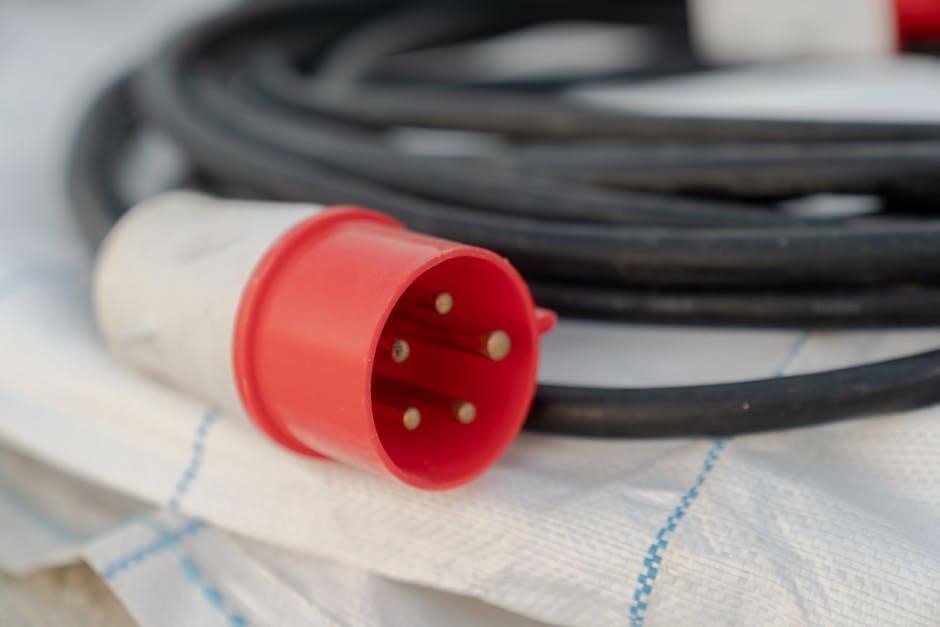Safety Precautions
Always check pressure release devices for clogs before use. Never open the Power Cooker until it has cooled and all pressure is released. Regular cleaning ensures safety devices function properly.
1.1 Important Safety Considerations
Always inspect the pressure release devices before use to ensure they are free from clogs. Never attempt to open the Power Cooker until it has completely cooled down and all internal pressure has been released. Forcing the lid open while pressurized can cause serious injury. Regularly clean the unit to prevent food fragments from obstructing safety mechanisms. Keep children away from the cooker while it is in operation. Avoid using unauthorized parts or modifications, as this could compromise safety. Follow the manufacturer’s instructions for maximum pressure levels and cooking times. Failure to adhere to these guidelines may result in hazardous situations. Always refer to the user manual for detailed safety protocols.
1.2 Understanding Pressure Release Devices
Pressure release devices are critical for safe operation of the Power Cooker. They are designed to release excess pressure automatically or manually. Always ensure these devices are free from obstructions, as clogs can prevent proper pressure release. Regular cleaning is essential to maintain their functionality. The Power Cooker features both primary and secondary safety valves to ensure pressure is regulated effectively. Never attempt to modify or tamper with these devices, as this could lead to malfunctions. Familiarize yourself with the manual release mechanism to safely depressurize the cooker before opening. Proper use and maintenance of these devices are vital to prevent accidents and ensure reliable performance. Refer to the user manual for specific instructions on inspecting and cleaning the pressure release systems.

1.3 Essential Safety Warnings
Always prioritize safety when operating the power cooker. Never touch the cooker’s exterior or lid during operation, as they may become extremely hot and cause burns. Use oven mitts or tongs to handle hot containers. Keep children and pets away from the cooker while it is in use. Avoid leaving the cooker unattended during operation. Do not use unauthorized parts or accessories, as they may cause malfunctions. Ensure the cooker is placed on a stable, heat-resistant surface, away from flammable materials. Never force the lid open; always allow the pressure to release naturally or via the pressure release device. Failure to follow these guidelines may result in injury or damage. Always read the user manual thoroughly before first use and adhere to all safety instructions provided.

Getting Started
Welcome to your power cooker! This section guides you through initial setup and preparation to ensure a smooth and safe cooking experience. Start exploring its features and enhancing your culinary skills with ease.
2.1 Unboxing and Initial Setup
Carefully unbox your power cooker and inspect all components, including the main unit, lid, power cord, and accessories. Ensure no damage occurred during shipping. Place the cooker on a stable, heat-resistant surface, away from flammable materials. Plug in the power cord, ensuring it is securely connected to both the cooker and a grounded electrical outlet. Before first use, wash the inner pot, lid, and accessories with mild soap and warm water. Dry thoroughly to prevent water spots. Familiarize yourself with the control panel and read the user manual to understand safety features and operation. Conduct a water test run to ensure proper function. This setup process ensures a safe and effective cooking experience. Proper initial setup is essential for optimal performance and longevity of your power cooker.
2.2 Quick Start Guide
To begin using your power cooker, plug it in and ensure the power cord is securely connected. Wash your hands and ensure the cooking area is clean. Add prepared ingredients to the inner pot, ensuring the liquid level meets the minimum requirement (typically 1-2 cups); Close the lid, aligning the arrows, and set the steam release handle to “sealing.” Press the power button, select your desired cooking mode (e.g., pressure cook, sauté, or slow cook), and adjust the timer and pressure level as needed. The default settings are suitable for most dishes. Once set, the cooker will start automatically. Keep the area clear and avoid opening the lid during operation. Allow the pressure to release naturally or use the quick-release method, depending on the recipe. This guide provides a swift and straightforward path to cooking with your power cooker.
2.3 First-Time Usage Instructions
Before your first use, rinse the inner pot, lid, and accessories with warm soapy water. Dry thoroughly and ensure all components are securely in place. Plug in the cooker and press the power button to activate it. Perform a quick test by adding 2 cups of water to the inner pot. Close the lid, set the steam release handle to “sealing,” and press the “manual” or “pressure cook” button. Set the timer to 5 minutes at low pressure. Allow the cooker to run through the cycle to ensure proper function. Once complete, release the pressure and inspect the components. This test ensures your cooker is ready for its first meal. Always refer to the manual for detailed guidance.
Understanding the Digital Control Panel
The digital control panel features user-friendly buttons for pressure cooking, sauté, delay start, and timer settings. The LCD display shows cooking progress and parameters clearly.
3.1 Overview of the Control Panel
The control panel is the central interface for operating the power cooker. It features a clear LCD display that shows cooking settings, timers, and progress. The panel includes buttons for selecting cooking modes, adjusting pressure levels, and setting timers. Navigation buttons allow users to scroll through options and confirm settings. The design is intuitive, with labeled buttons for easy identification. The panel also includes a power button and a cancel button to stop or pause cooking. LED indicators provide visual feedback for active functions. The layout ensures that all essential controls are within easy reach, making it simple to customize and monitor cooking processes effectively. This user-friendly design helps beginners and experienced users alike to operate the cooker with confidence and precision.
3.2 Navigating the Menu Options
Navigating the menu options on the power cooker is straightforward and intuitive. The control panel features a scrollable menu accessed via the navigation buttons. Use the up and down arrows to cycle through options like cooking modes, timer settings, and pressure levels. Press the “Select” or “Start” button to choose an option. The menu is divided into primary and advanced functions, ensuring easy access to common settings. A back button allows users to return to previous screens without resetting the device. The menu also includes pre-programmed settings for popular dishes, making it easy to select a cooking mode tailored to your recipe. This streamlined interface ensures users can efficiently navigate and customize their cooking experience with minimal effort. The design prioritizes user convenience, reducing the learning curve for new users while providing advanced options for experienced cooks.
3.3 Setting the Timer and Pressure Levels
Setting the timer and pressure levels on the power cooker is a simple process. Use the control panel to navigate to the timer and pressure settings. Press the “Timer” button to adjust the cooking duration using the “+” and “-” buttons. For pressure levels, select “High” or “Low” pressure depending on the recipe. The cooker allows you to set precise pressure levels, ensuring optimal results. Some models also feature a “Manual” mode for custom settings. After setting the timer and pressure, press “Start” to begin cooking. Always ensure the lid is properly sealed before cooking under pressure. The cooker will automatically adjust to maintain the selected pressure level, providing consistent cooking performance. This feature ensures dishes are cooked evenly and safely. Adjustments can be made mid-cycle if needed.

Cooking Basics
Master the fundamentals of pressure cooking by understanding ingredient preparation, liquid ratios, and basic cooking techniques. Always follow recipe guidelines for best results.
4.1 Preparing Ingredients for Pressure Cooking
Properly preparing ingredients is essential for safe and effective pressure cooking. Wash and chop vegetables, meats, and grains as needed. Ensure all ingredients are fresh and suitable for pressure cooking. Seasonings and spices can be added directly to the pot. For tougher cuts of meat, marinating beforehand can enhance tenderness. Always slice or dice ingredients to uniform sizes for even cooking. Certain foods, like beans and grains, may require rinsing or pre-soaking. Avoid overfilling the cooker, as this can lead to uneven cooking. For delicate foods like fish or eggs, use a steamer basket to prevent damage. Always refer to specific recipe guidelines for optimal results. Proper preparation ensures safety, flavor, and desired texture; Use a food thermometer for meats if necessary. Adjust ingredient sizes based on cooking time and pressure levels. Never skip preheating steps for certain recipes. Keep ingredients ready before starting the cooking process. Always follow safety guidelines when handling sharp objects or hot pans during preparation.
4.2 Adding Liquid and Sealing the Lid

Adding the correct amount of liquid is crucial for pressure cooking. Minimum liquid required is typically 1-2 cups, depending on the recipe. Use water, broth, or other cooking liquids, but avoid thick sauces that may clog the valve. Pour the liquid directly into the pot, ensuring it covers the bottom. Place ingredients in a steamer basket if needed. To seal the lid, align it with the cooker’s rim and close it firmly; Ensure the valve is set to the “sealing” position. Double-check the lid is locked securely; the cooker won’t pressurize otherwise. Avoid overfilling, as excessive liquid can lead to poor results. Always verify the lid is properly sealed before starting the cooker. For safety, keep hands away from the steam release valve during operation.
4.3 Starting the Cooking Process

To begin cooking, press the power button and select your desired cooking mode using the digital control panel. Choose from options like “Manual,” “Soup,” or “Meat” based on your recipe. Use the “+” or “-” buttons to set the cooking time and pressure level. Press “Start” to initiate the process. The cooker will first preheat before building pressure. Once pressurized, the timer will begin counting down. Avoid opening the lid during cooking, as this will release pressure and interrupt the process. After cooking completes, allow the pressure to release naturally or use the quick-release valve if instructed. Always ensure the lid is sealed properly before starting. For best results, avoid disturbances during the cooking cycle. The cooker will automatically switch to “Keep Warm” mode after completion.

Maintenance and Cleaning
Regularly clean the power cooker after each use to prevent food residue buildup. Wipe the exterior with a damp cloth and clean the inner pot thoroughly. Always check and clear the steam vent for blockages to ensure proper function. For tougher stains, soak parts in warm soapy water before scrubbing. Descale the cooker periodically to remove mineral deposits. Store the appliance in a dry place to prevent rust. Refer to the user manual for specific cleaning instructions tailored to your model. Cleaning ensures optimal performance and extends the lifespan of your power cooker. Always unplug before cleaning for safety.
5.1 Cleaning the Power Cooker
Cleaning the power cooker is essential for maintaining its performance and hygiene. Always unplug the appliance before cleaning. Start by washing the inner pot, lid, and accessories with warm soapy water. Use a soft sponge or cloth to avoid scratching the surfaces. For tougher stains, soak the parts in hot water mixed with mild detergent. The exterior can be wiped clean with a damp cloth. Regularly clean the steam vent and sealing ring to ensure proper sealing and pressure release. Avoid using abrasive cleaners or scourers, as they may damage the finish. Dry all components thoroughly after cleaning to prevent rust. For stubborn food residue, mix baking soda and water to create a paste, apply it to the affected areas, and let it sit before scrubbing. Regular cleaning ensures your power cooker remains in optimal condition.
5.2 Regular Maintenance Tips
Regular maintenance ensures your power cooker operates efficiently and lasts longer. Check the sealing ring monthly and replace it if worn or cracked. Descale the cooker every 3-6 months if you live in an area with hard water to prevent mineral buildup. After each use, wipe the lid and edges with a damp cloth to remove food residue. Lubricate the lid’s rubber gasket occasionally with cooking oil to maintain flexibility. Inspect the steam vent and pressure valve for blockages and clean them with a small brush or toothpick. Avoid using abrasive cleaners, as they can damage the finish. Store the cooker in a dry place when not in use. Follow a maintenance schedule to keep your power cooker in prime condition and ensure safe, reliable performance.
5.3 Troubleshooting Common Issues
If your power cooker isn’t functioning properly, check for common issues. If it won’t turn on, ensure it’s properly plugged in and the outlet is working. For a lid that won’t seal, inspect for food residue or misalignment. Clean the sealing ring and ensure it’s correctly positioned. If the cooker isn’t pressurizing, check the steam valve for blockages or ensure it’s closed tightly. Water leaking from the valve may indicate a worn sealing ring. If the display shows an error code, consult the user manual for specific solutions. Regularly cleaning and descaling can prevent many issues. If problems persist, contact customer support for assistance. Proper troubleshooting ensures safe and efficient cooking.

Advanced Features and Techniques
Explore advanced cooking modes like sauté, slow cook, and yogurt making. Master techniques such as layering ingredients, precision temperature control, and custom pressure settings for enhanced meal versatility.
6.1 Using Advanced Cooking Modes
The power cooker offers multiple advanced cooking modes to enhance your culinary experience. The sauté mode allows for browning ingredients before cooking, while the slow cook mode is ideal for tenderizing tougher cuts of meat over extended periods. Additionally, the yogurt mode enables you to make homemade yogurt with precise temperature control. To access these modes, navigate to the control panel and select the desired option using the directional buttons. Each mode comes with customizable settings, such as temperature adjustments or cooking durations, to suit your recipe needs. Experiment with these features to explore a wide range of dishes, from hearty stews to probiotic-rich yogurt. This versatility ensures your power cooker becomes a multi-functional kitchen companion.
6.2 Pressure Cooking Techniques
Mastering pressure cooking techniques can elevate your dishes to new heights. Always ensure sufficient liquid is added, as this generates the steam necessary for pressure buildup. Properly sealing the lid is crucial to avoid leaks and maintain pressure. Cooking times vary depending on the ingredient, so refer to guidelines for specific foods. Natural pressure release (NPR) is ideal for delicate dishes, while quick release (QR) is better for heartier meals. Layering ingredients can help prevent scorching, and Deglazing after cooking adds depth to sauces. Experiment with these methods to achieve perfectly cooked meals every time. These techniques ensure your power cooker performs optimally, delivering flavorful and tender results consistently.
6.3 Converting Recipes for Pressure Cooking

Converting traditional recipes for pressure cooking requires adjustments to time, liquid, and seasoning. Generally, cooking times are reduced by 70% compared to conventional methods. Liquids should be minimized, as pressure cookers trap steam, potentially making dishes too watery. Brown ingredients before pressure cooking for enhanced flavor. Avoid overfilling the cooker, as this can block the pressure valve. For grains and legumes, use specific ratios of water to ingredient. When adapting recipes, start with shorter cooking times and adjust in subsequent attempts; Always consult the user manual for guidance on converting specific types of recipes. Experimenting with familiar dishes is a great way to refine your technique and achieve consistent results with your power cooker.

Additional Resources
For further assistance, visit the official website for user manuals, troubleshooting guides, and FAQs. Join online forums for tips and recipes. Contact customer support for warranty inquiries and technical help. Websites and toll-free numbers are provided in the manual for convenient access to resources.
7.1 Where to Find User Manuals
Your power cooker user manual is readily available on the official manufacturer’s website. Visit the support section and navigate to the downloads page. Enter your model number to access the PDF version, which can be downloaded or printed. If you misplaced the physical copy, this digital version ensures you always have the instructions handy. Additionally, manuals may be included on the product’s packaging or provided via email upon purchase. For convenience, some manufacturers also offer mobile-friendly versions of the manual through their official apps. Ensure you refer to the correct model-specific manual for accurate information. This resource is essential for troubleshooting and understanding advanced features.
7.2 Online Communities and Forums
Online communities and forums are valuable resources for power cooker users seeking guidance, tips, and troubleshooting advice. Platforms like Facebook groups, Reddit forums, and specialized cooking communities offer spaces to connect with fellow users and experts. These forums often feature detailed discussions on various power cooker models, shared recipes, and solutions to common issues. Many manufacturers also host official forums or social media groups where users can interact directly with support teams. By joining these communities, you can gain insights, learn new techniques, and resolve any doubts you may have. Active participation in these forums can enhance your overall power cooker experience and help you make the most of your appliance.
7.3 Customer Support and Warranty Information
Customer support and warranty information are crucial for ensuring a smooth experience with your power cooker. Most manufacturers offer dedicated customer support teams available via phone, email, or live chat. Warranty coverage typically includes repair or replacement for defective parts within a specified period. Be sure to register your product to activate the warranty and access exclusive benefits. For troubleshooting or maintenance inquiries, support agents can provide guidance tailored to your needs. Additionally, many brands offer extended warranty options for added peace of mind. Always refer to the user manual or the manufacturer’s website for detailed warranty terms and conditions. Reaching out to customer support early can prevent minor issues from becoming major problems.
